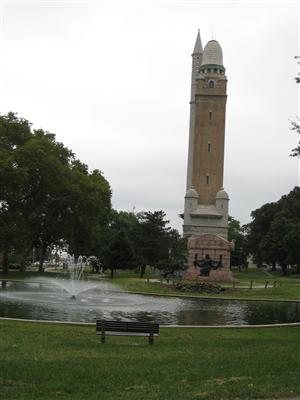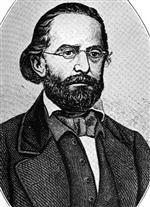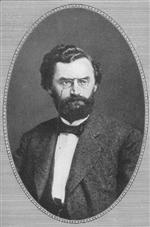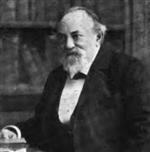The Naked Truth German-American Memorial
Tour Stop

Directions: The Naked Truth German-American Memorial [ Waypoint = N38 36.867 W90 14.346 ] is located in Compton Hill Reservoir Park at the corner of Grand Blvd and Russell Blvd in St. Louis, Missouri 63104.
- Return to Gravois Road and turn right to get headed north.
- After about 3.2 miles, turn left (north) onto Grand Boulevard.
- After about 1.5 miles, turn right (east) onto Russell Boulevard and find a place to park.
- Compton Hill Reservoir Park is on the north side of Russell Boulevard.
- The Naked Truth German-American Memorial is in the west central part of the part just south of the Reservoir Tower.

Description: The Naked Truth Memorial was built to commemorate Carl Schurz, Emil Preetorius, and Carl Daenzer; three prominent German-Americans associated with St. Louis’ two most influential German newspapers, Anzieger des Westens and Westliche Post. But the memorial also honors the contributions of the thousands of German-Americans throughout the history of St. Louis and Missouri. The Naked Truth is made of bronze. The woman is said to represent truth while the two torches are said to represent the enlightenment of Germany and the United States. [146]
The inscription (in both English and German) on the back of the memorial reads as follows:
As German-Americans and leaders of their compatriots in public life, it was ever their lofty aim and steady purpose to prove true to the land of their adoption and to serve it faithfully and well independent characters striving with ardent zeal for everything that is great and beautiful in life they brought with them the precious treasures of Germania's culture and placed them, a blessing for all coming generations, in Columbia's keeping. Erected by their grateful fellow-citizens in recognition of their services.
Erected Anno 1914 by the Praetorius=Schurz=Daenzer Memorial Association

Publishing its first edition in 1835, the Anzieger des Westens became known for its editorial opposition to the institution of slavery. By 1846, with the financial support of Arthur Olshausen, the Anzieger des Westens began publishing daily editions. In 1850, Henry Boernstein became the newspaper's editor and in 1854 Boernstein's editorial leadership put the Anzieger des Westens strongly in support of the abolition of slavery and the Republican Party. During the war, the Anzieger des Westens languished, but was revived in 1863 by Carl Daenzer. The Westliche Post was a German daily newspaper established in St. Louis in 1857 by Carl Daenzer. This newspaper was a very influential advocate for Republican policies and candidates, playing a key role in St. Louis just before and during the American Civil War. [147]
German-Americans had a tremendous influence on St. Louis and Missouri during the American Civil War. More than one third of all of the Federal volunteers who served in the army were Americans that had been born in Germany. [148]

Born in Germany, Carl Schurz became involved in the revolutionary movements of 1848 and 1849. After the collapse of the revolution in Germany, Schurz was forced into exile, eventually emigrating to the United States in 1852. By 1855, Schurz had moved to Wisconsin and had joined the Republican Party. He actively campaigned for Lincoln in both his Senate and Presidential campaigns. During the war, Schurz was commissioned a Brigadier-General of Federal Volunteers, eventually rising to Major-General of Federal Volunteers. He would lead troops in the Second Battle of Bull Run and the Battles of Chancellorsville, Gettysburg, and Chattanooga. Schurz arrived in St. Louis in 1867 to join the Westliche Post as an editor and part-owner. It is interesting to note that shortly after joining the newspaper, Schurz hired Joseph Pulitzer in 1867 to work as a reporter for the newspaper. In 1869, Schurz would be elected to the United States Senate, representing the State of Missouri. [149]

Born in Germany, Carl Daenzer also became involved in the German revolutionary movements of 1848 and 1849. He, too, went into exile when the German Confederation defeated the revolutionaries and arrived in St. Louis in 1851. Daenzer was hired by Henry Boernstein to work at the Anzieger des Westens, but Daenzer would leave in 1857 to start his own newspaper, the Westliche Post. His new newspaper was decidedly Republican and exerted a powerful influence with Missouri's German-American population during the war. When the Anzieger des Westens ceased publication after the start of the Civil War, Daenzer acquired the newspaper in 1863 and started it up again. [150]

Born in Germany, Emil Preetorius became involved in the revolutionary movements of 1848 and 1849 and was forced from Germany into exile in 1850. Arriving in St. Louis, Missouri in 1854. Emil Preetorius was an ardent abolitionist and was active in raising German-American volunteer regiments to fight for the United States during the Civil War. Elected to the Missouri State Legislature in 1862, Preetorius actively campaigned for Lincoln's re-election in 1864. Preetorius became editor-in-chief for the Westliche Post in 1864. From 1892-1893, Preetorius served as the president of the Missouri Historical Society. [151]
